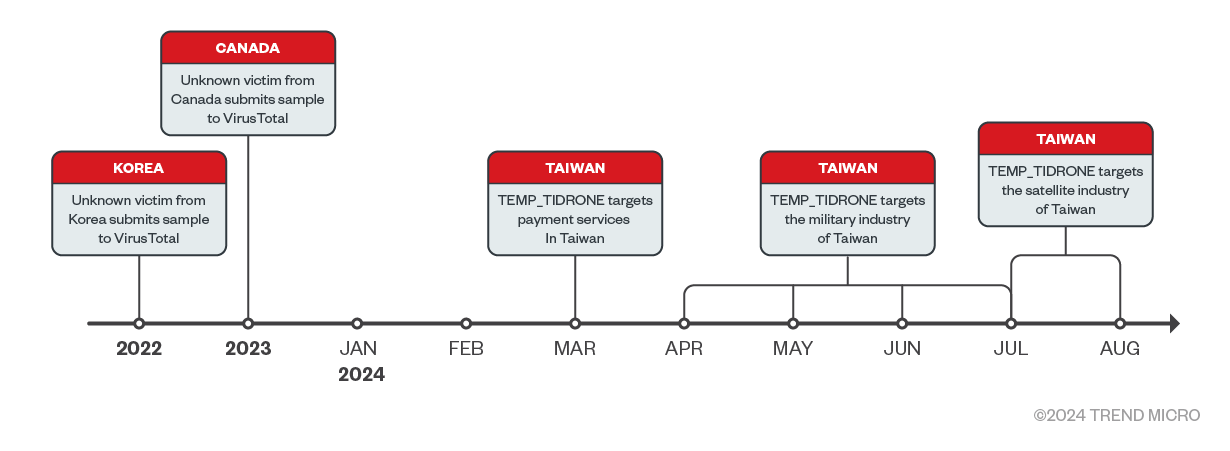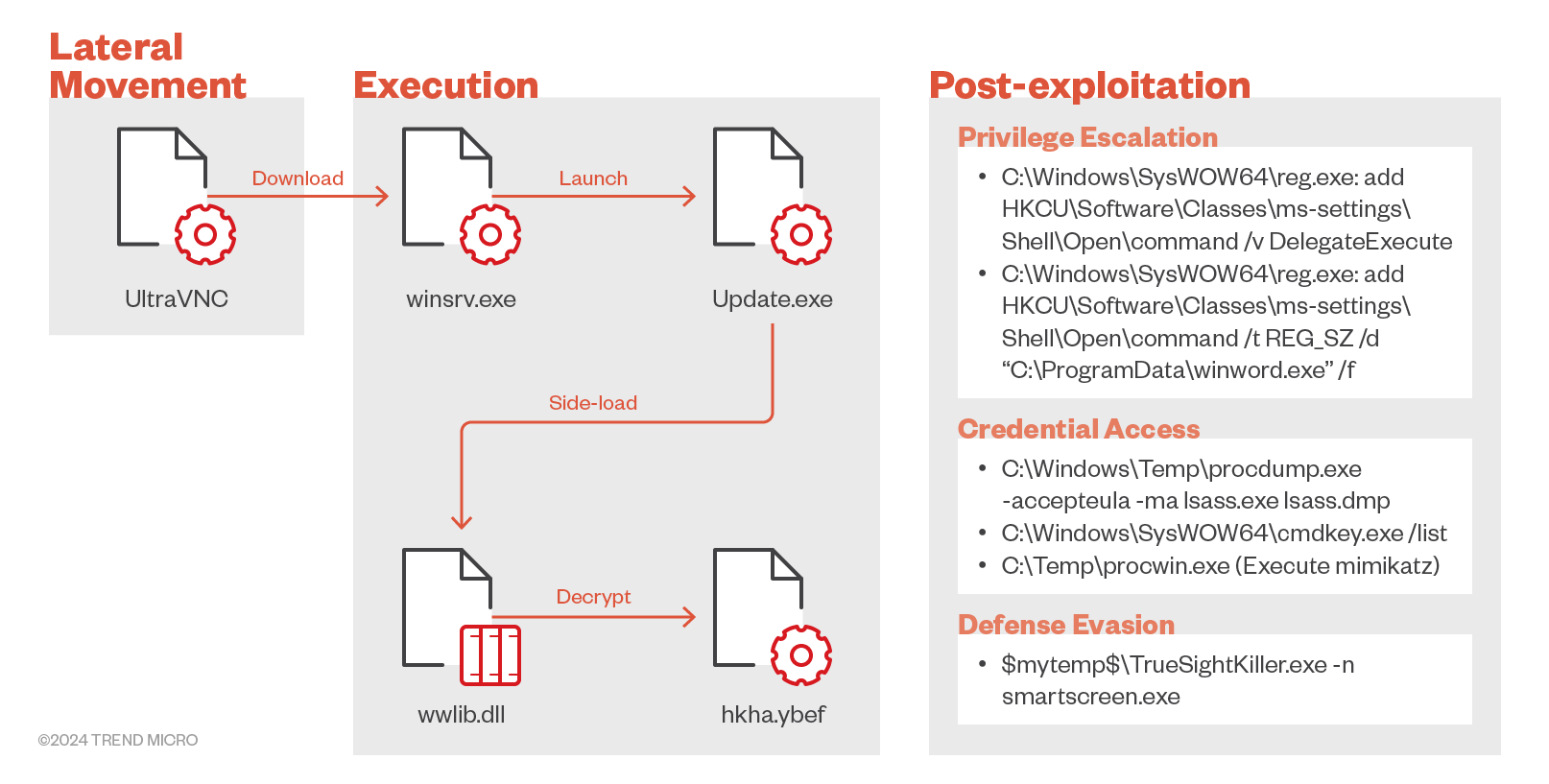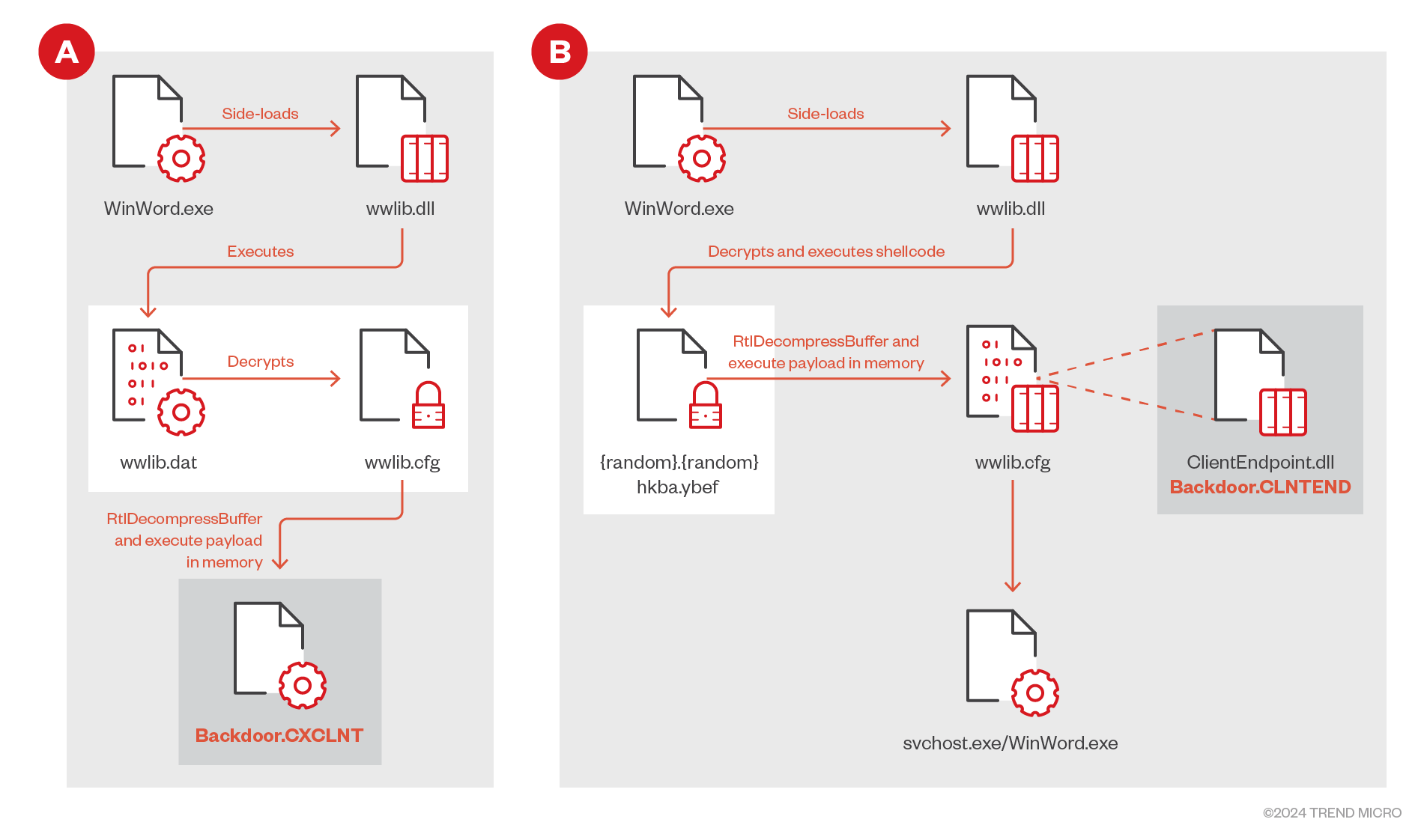Summary
- TIDRONE, an unidentified threat actor linked to Chinese-speaking groups, has demonstrated significant interest in military-related industry chains, especially in the manufacturers of drones’ sector in Taiwan.
- The threat cluster uses enterprise resource planning (ERP) software or remote desktops to deploy advanced malware toolsets such as the CXCLNT and CLNTEND.
- CXCLNT has basic upload and download file capabilities, along with features for clearing traces, collecting victim information such as file listings and computer names, and downloading additional portable executable (PE) files for execution.
- CLNTEND is a newly discovered remote access tool (RAT) that was used this April and supports a wider range of network protocols for communication.
- During the post-exploitation phase, telemetry logs revealed user account control (UAC) bypass techniques, credential dumping, and hacktool usage to disable antivirus products.
Introduction
Since the beginning of 2024, we have been receiving incident response cases from Taiwan. We track this unidentified threat cluster as TIDRONE. Our research reveals that the threat actors have shown significant interest in military-related industry chains, particularly in the manufacturers of drones. Furthermore, telemetry from VirusTotal indicates that the targeted countries are varied; thus, everyone should stay vigilant of this threat.
This report also investigates the latest TTPs and the evolution of tools like CXCLNT and CLNTEND, presenting the attack chain to illustrate the threat actor's behavior within victims' systems. The TTPs confirm that the threat actors have consistently updated their arsenal and optimized the attack chain. Notably, anti-analysis techniques are employed in their loaders, such as verifying the entry point address from the parent process and hooking widely-used Application Programming Interfaces (APIs) like GetProcAddress to alter the execution flow.

Execution Flow
Based on how the malware set was deployed into the victim's environment, we can infer that it likely leveraged other tools to infiltrate the system some time ago and has now progressed to the lateral movement stage.
In this case study we reviewed CXCLNT/CLNTEND and its related components, including the launcher and a legitimate executable for side-loading, which were downloaded via UltraVNC, a program that allows users to remotely control the server computer using their mouse and keyboard. During our investigation, we discovered the same ERP system was present in the environments of different victims, suggesting that the malware might be distributed through a supply chain attack.
After executing winsrv.exe, the malware copies the token from Winlogon.exe to escalate privileges and perform malicious activities. The original Update.exe located in a chosen directory is then replaced with one provided by the threat actors. During the post-exploitation phase, we observed UAC Bypass, credential dumping, and usage of commands aimed at disabling antivirus products, as seen in the telemetry logs.

Technical Analysis
This section will further explain the toolsets this threat cluster uses, such as malware CXCLNT and CLNTEND, and the TTPs we found between previous activities (A) and recent activities (B) as shown in the illustration below.

Loaders
We have identified two kinds of loaders from VirusTotal and the client side, which each correspond to one infection chain. In this first version (A in Figure 3), the loaders create a service with the name for persistence on the victim side (the service name in our received case is ASProxys) and set '-s' for the first argument in the command line to make sure the process will be started from the service in the next execution. In decryption, the loaders need two payloads (wwlib.dat, and wwlib.cfg). The former is the shellcode with a decryption routine to decrypt the later one.
However, these two payloads are merged into a single encrypted payload in the second version (B in Figure 3) but keep the decryption routine in the shellcode part:
- RtlDecompressBuffer to decrypt the PE file.
- Execute the entry point of the PE file.
- Execute the assigned export function of the PE file. (“TgSetup” in the first version, “InstallSetup” in the second version)
Additionally, some extra features are implemented in the second version's loader:
Anti-Analysis technique
- Read the entry point to check the parent process.
- Hook GetProcAddress by overwriting the code inside the original one.
Anti-Antivirus: API with callback
The loaders do not utilize the common API to start a new thread, like CreateThread and _beginthread. Here are the steps to introduce this unseen method:
- ConvertThreadToFiber to build a Fiber structure.
- CreateFiber to enter a new thread (but the input address is junk code).
- Overwrite the address in the Fiber structure (+0xC4) by the desired function.
- Enter the desired function by API, SwitchToFiber.

Backdoor
According to our observation, we have identified two different backdoors in this campaign. Due to the code structure, the shellcode is flexible enough to accept various formats of files such as the exe and dll for the final payload.
EXE (Backdoor.CXCLNT)
One of the final payloads is a non-landed executable that collects the victim’s information such as IP, MAC address, Computer Name, Product Name, and system architecture. By analyzing the packet transmission contents, we can infer the packet format.
There will be two decryption steps: the first key will be placed at position [start+0x8], and the second key will be placed at position [start+0x12]. Then, through a customized XOR encryption and decryption process, this encrypted packet can be successfully deciphered.


However, upon analyzing this sample, we found that the command and control (C&C) server was no longer active. Tracing the APIs used in malware and the recorded pcap file from the sandbox report, we inferred possible functionalities. By comparing the decrypted packet contents with the command codes hardcoded in the malware, we concluded that this backdoor might possess the following capabilities.
Command code |
Description |
0x1001 |
Send victim information to C&C server |
0x1002 |
Pass but do nothing |
0x1003 |
SetEvent |
0x1004 |
Receive unknown data, while not being sure of the purpose |
0x1005 |
Clear footprints and
|
0x1006 |
Persistence via setting reg |
0x2001 |
Receive the size of the payload from the C&C server |
0x2002 |
Receive a dll file from the C&C server |
0x2003 |
Call the export functions of the received dll from 0x2002 |
0x2004 |
UNKNOWN |
0x2005 |
Check connections alive |
0x2007 |
Send listed files in a specific folder to the C&C server |
Table 1. Backdoor command code of CXCLNT
DLL (Backdoor.CLNTEND)
Another final payload is a non-landed dll with the internal name “install.dll”. In the export function, InstallSetup, there are three paths based on the value in configuration:
- SvcLoad → Create a service with the name “CertPropSvce” and inject the next payload, ClientEndPoint.dll, into the current process or svchost process (Depending on configuration).
- TaskLoad → Create a task with the name “CertificatePropagatione” and inject the next payload, ClientEndPoint.dll, into the current process or svchost process (Depending on configuration).
- Other: Directly inject the next payload, ClientEndPoint.dll, into the current process or svchost process (Depending on configuration).
ClientEndPoint.dll is a remote shell tool and observed commands are shown in Figure 3. It supports these protocols for communication with the C&C server:
- TCP
- HTTP
- HTTPS
- TLS
- SMB(port:445)
Based on our experience, threat actors prefer the C&C server domain with a misquoted name, like symantecsecuritycloud[.]com, microsoftsvc[.]com, and windowswns[.]com, whether it is for CLNTEND and CXCLNT. They all implement a similar naming convention to mislead the investigation for network infrastructure.
Attribution Analysis
The consistency in file compilation times and the threat actor’s operation time with other Chinese espionage-related activities supports the assessment that this campaign is likely being carried out by an as-yet unidentified Chinese-speaking threat group. The incidents we observed were highly targeted and limited in scope. The focus on military-related industry chains, particularly in the manufacturers of drones, suggests an espionage motive, given the sensitive data these entities typically hold. This further reinforces the likelihood that TIDRONE is engaged in espionage-related activities.
WinWord.exe
Due to the same parent process (WinWord.exe) operation from threat actors, the organizations can defend against the attack from TIDRONE by staying vigilant of the following variations:
- WinWord.exe (sha256: 8cfb55087fa8e4c1e7bcc580d767cf2c884c1b8c890ad240c1e7009810af6736). Beware that it has the child process cmd.exe due to the remote shell functionality.
- WinWord.exe (sha256: 8cfb55087fa8e4c1e7bcc580d767cf2c884c1b8c890ad240c1e7009810af6736) with “-s“ in the first argument of the cmd line.
- WinWord.exe (sha256: 8cfb55087fa8e4c1e7bcc580d767cf2c884c1b8c890ad240c1e7009810af6736) with “/SvcLoad“ or “/TaskLoad” in the last argument of the cmd line.
Conclusion
In this article, we investigated TIDRONE, a threat actor linked to Chinese-speaking groups. The attacks were detected in Taiwan and mostly targeted military-related industries, specifically the manufacturer of drones. The activities involve advanced malware variants such as CXCLNT and CLNTEND which were spread through ERP software or remote desktops. We examined the technical details of these malicious activities to keep users informed about these types of threats.
Some of the steps that organizations can take to protect themselves are as follows:
- Download software only from trusted sources
- Stay vigilant of social engineering lures that threat actors could use as entry points for attacks
- Employ antimalware software that could detect early signs of compromise no matter where they are in the system
Trend Micro Vision One offers multilayered protection for diverse environments. With comprehensive prevention, detection, and response capabilities, it safeguards systems from breaches and attacks.
Indicators of Compromise (IOCs)
File
SHA-256 |
Detection |
f13869390dda83d40960d4f8a6b438c5c4cd31b4d25def7726c2809ddc573dc7 |
Trojan.Win32.CXCLNT.ZTLH |
e366f0209a939503418f2b7befbd60b79609b7298fed9c2fbafcb0e7fde19740 |
Trojan.Win32.CXCLNT.ZTLH |
6cb08a458e35101ef1035e7926130e1394cc1764a10166628aff541834c67063 |
Trojan.Win32.CXCLNT.ZTLH |
19bbc2daa05a0e932d72ecfa4e08282aa4a27becaabad03b8fc18bb85d37743a |
Trojan.Win32.CXCLNT.ZTLH |
eea0f94c6a8f18275c3dac1e1b9e9d3240e37073ff391852e8ff8d8391efa9aa |
Trojan.Win32.CXCLNT.ZTLH |
0d91dfd16175658da35e12cafc4f8aa22129b42b7170898148ad516836a3344f |
Trojan.Win32.CXCLNT.ZTLH |
1b08f1af849f34bd3eaf2c8a97100d1ac4d78ff4f1c82dbea9c618d2fcd7b4c8 |
Trojan.Win32.DULLOAD.ZTLC |
4b5f609c6b6788bdf0b900dd3df3c982cd547e7925840000bdc4014f8a980070 |
Trojan.Win32.SHELLDEBIN.ZTLC |
1f22be2bbe1bfcda58ed6b29b573d417fa94f4e10be0636ab4c364520cda748e |
Backdoor.Win32.CXCLNT.ZTLC.enc |
3b8f10a780eb64a3c59a2ae85fec074faf0f1a8d9725fb111f5cbf80e7b0dc1b |
Backdoor.Win32.CLNTEND.ZTLH.enc |
db600b0ae5f7bfc81518a6b83d0c5d73e1b230e7378aab70b4e98a32ab219a18 |
Backdoor.Win32.CLNTEND.ZTLH.enc |
1bf318c94fa7c3fb26d162d08628cef54157dfeb2b36cf7b264e3915d0c3a504 |
Backdoor.Win32.CLNTEND.ZTLH.enc |
f3897381b9a4723b5f1f621632b1d83d889721535f544a6c0f5b83f6ea3e50b3 |
Backdoor.Win32.CLNTEND.ZTLH.enc |
Network
- bestadll[.]fghytr[.]com
- client[.]wns[.]windowswns[.]com
- server[.]microsoftsvc[.]com
- service[.]symantecsecuritycloud[.]com
- time.vmwaresync[.]com

